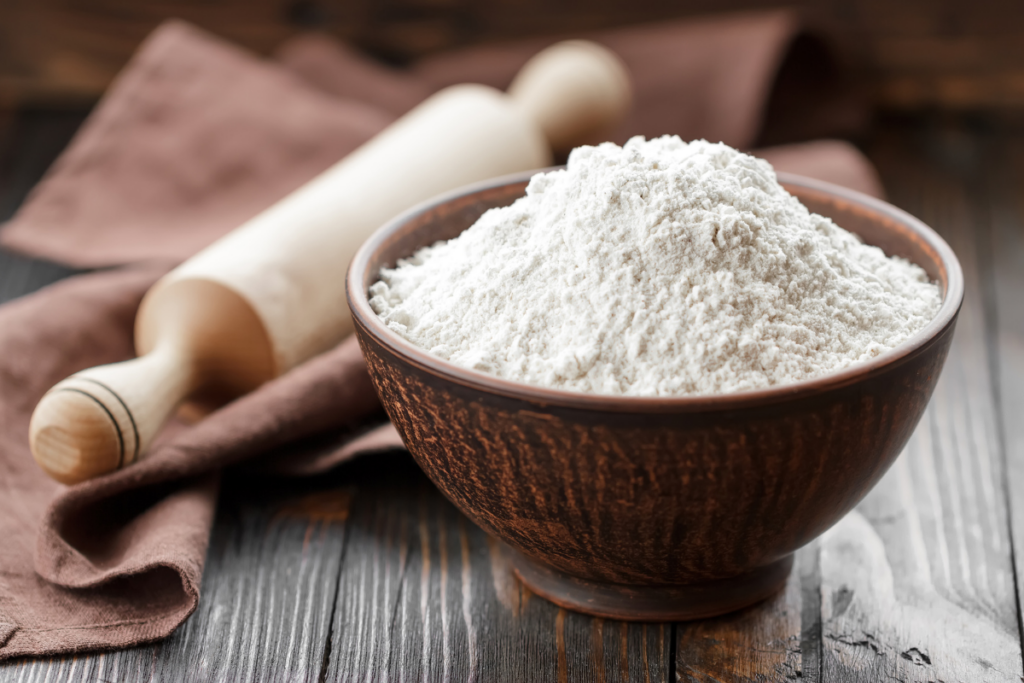Have you ever thought, what is the difference between all purpose flour and bread flour when you are baking?
If yes, then you are not alone.
Many people struggle to understand the difference between all-purpose flour and bread flour.
While both types of flour are used in baking, they have different properties that make them suitable for specific recipes.
All-purpose flour is a versatile flour that can be used in a variety of recipes, including cakes, cookies, and bread.
It is made by milling a combination of hard and soft wheat, which gives it a protein content of around 10-12%.
This protein content makes it suitable for recipes that require a moderate amount of gluten development, such as cakes and cookies.
On the other hand, bread flour is made from hard wheat and has a higher protein content of around 12-14%.
This higher protein content makes it ideal for recipes that require a stronger gluten structure, such as bread and pizza dough.

What Is The Difference Between All Purpose Flour And Bread Flour?
If you’re an avid baker, you’ve likely come across recipes calling for either all-purpose flour or bread flour.
While they may seem interchangeable, there are some key differences between the two.
In this section, we’ll explore what sets all-purpose flour and bread flour apart.
What is All Purpose Flour?
All-purpose flour is a versatile type of flour that is suitable for a wide range of baked goods.
It is a blend of hard and soft wheat, which gives it a moderate protein content of around 10-12%.
All-purpose flour is commonly used in recipes for cakes, cookies, muffins, and quick breads.
What is Bread Flour?
Bread flour, on the other hand, is specifically designed for use in yeast breads.
It is made from hard wheat, which has a higher protein content of around 12-14%.
This higher protein content gives bread dough the strength it needs to rise and hold its shape during baking.
Protein Content
The main difference between all-purpose flour and bread flour is their protein content.
As mentioned earlier, all-purpose flour has a protein content of around 10-12%, while bread flour has a protein content of around 12-14%.
The higher protein content in bread flour gives it the gluten-forming ability necessary for bread dough to rise and hold its shape.
Usage
All-purpose flour is a versatile flour that can be used in a wide variety of baked goods.
It is suitable for cakes, cookies, muffins, quick breads, and more.
Bread flour, on the other hand, is specifically designed for use in yeast breads.
It is not recommended for use in other types of baked goods.
Texture and Taste
The difference in protein content between all-purpose flour and bread flour also affects the texture and taste of baked goods.
Bread flour produces a denser, chewier texture in bread, while all-purpose flour produces a lighter, softer texture.
Bread flour also has a slightly nuttier flavor compared to all-purpose flour.
In summary, all-purpose flour and bread flour have different protein contents, which affects their suitability for different types of baked goods.
All-purpose flour is a versatile flour suitable for a wide range of baked goods, while bread flour is specifically designed for use in yeast breads.

Choosing The Right Flour
When it comes to choosing flour for your recipes, it’s important to consider the protein content.
Different types of flour have varying levels of protein, which affects the texture and structure of your baked goods.
All-purpose flour and bread flour are two of the most commonly used flours in baking and cooking.
Here’s what you need to know to choose the right flour for your needs.
For Baking
If you’re making bread or other baked goods that require a chewy, dense texture, bread flour is the way to go.
Bread flour has a higher protein content than all-purpose flour, usually between 11 and 14 percent.
This higher protein content creates more gluten, which gives bread its chewy texture and helps it rise properly.
On the other hand, if you’re making cakes, cookies, muffins, or other baked goods that require a lighter texture, all-purpose flour is the better choice.
All-purpose flour has a protein content of around 8 to 12 percent, making it more versatile for a variety of recipes.
Here’s a quick breakdown of the protein content of different types of flour:
| Flour Type | Protein Content |
|---|---|
| Bread Flour | 11-14% |
| All-Purpose Flour | 8-12% |
| Cake Flour | 5-8% |
| Pastry Flour | 8-10% |
For Cooking
While all-purpose flour is a great choice for baking, it’s also a versatile ingredient for cooking.
You can use it to thicken sauces, gravies, and soups, or to coat meat or vegetables before frying.
Bread flour, on the other hand, is not recommended for cooking.
Its high protein content makes it too dense and chewy for most recipes.
When using flour as a thickener, it’s important to use the right amount.
Too much flour can make your dish thick and pasty, while too little can result in a thin, watery consistency.
A general rule of thumb is to use 1 tablespoon of flour per cup of liquid for a medium-thick sauce or gravy.
In summary, choosing the right flour for your recipe is key to achieving the desired texture and structure.
Bread flour is best for chewy, dense baked goods like bread, while all-purpose flour is more versatile for a variety of recipes.
When cooking, all-purpose flour is a great choice for thickening sauces and gravies.

Key Takeaways
When it comes to baking, choosing the right flour is crucial.
All-purpose flour and bread flour are two of the most commonly used flour in baking.
Here are some key takeaways to keep in mind when deciding which flour to use:
- Bread flour has a higher protein content than all-purpose flour, which makes it ideal for bread and other baked goods that require a strong, chewy texture.
- All-purpose flour has a lower protein content, which makes it better for cakes, cookies, and other baked goods that require a softer texture.
- The higher protein content in bread flour also means that it develops more gluten when mixed with water, resulting in a stronger, more elastic dough.
- All-purpose flour, on the other hand, develops less gluten, resulting in a more tender crumb.
- While bread flour and all-purpose flour are not interchangeable in all recipes, they can often be substituted for one another with some adjustments.
- If a recipe calls for bread flour and you only have all-purpose flour, you can try adding a tablespoon of vital wheat gluten per cup of flour to increase the protein content.
- If a recipe calls for all-purpose flour and you only have bread flour, you can try using a little less flour or adding more liquid to compensate for the higher protein content.
- Bread flour has a slightly nutty flavor that can add depth to baked goods, while all-purpose flour has a more neutral flavor that allows other ingredients to shine.
- Overall, choosing the right flour for your recipe can make a big difference in the final result.
By understanding the differences between all-purpose flour and bread flour, you can make informed decisions about which flour to use in your baking.
